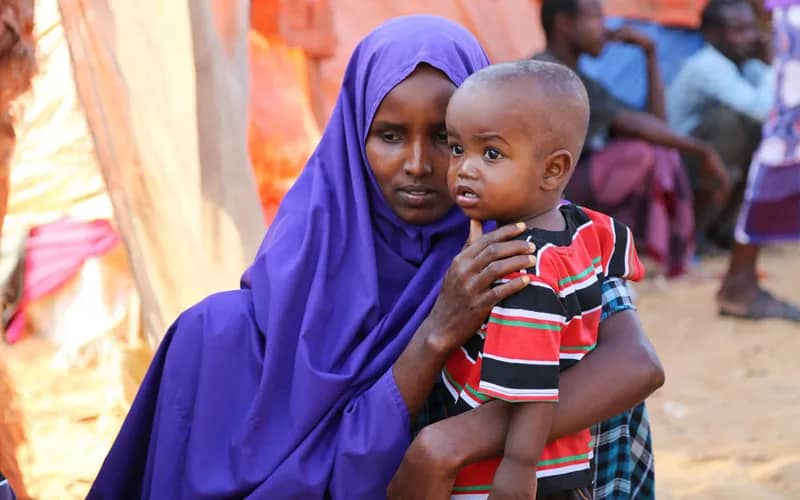YAOUNDÈ, Cameroon – Years of drought in Kenya have decimated food production, killed millions of livestock and produced chronic food insecurity for millions of people, all of which have combined to prevent untold numbers of children from receiving an education, thus consigning them to even more entrenched poverty.
One organization attempting to break that cycle is Mary’s Meals, a Catholic-inspired Scottish charity that provides school feeding programs in some of the world’s most impoverished settings. In started modestly in 2007, working in informal settlements that had sprung up in the wake of widespread violence following a disputed election that left roughly 1,500 dead and around 600,000 displaced.
In 2018, Mary’s Meals expanded its services to Kenya’s Turkana County, one of the areas worst hit by drought.
“As a result of this severe drought, the region has faced acute food insecurity, reaching Crisis (IPC Phase 3) and even worse food insecurity levels in October to December 2022,” said Mary’s Meals country director in Kenya, Amina Swedi.
In an exclusive interview with Crux, Swedi said the charity is now feeding an additional 60,000 children “in drought-ravaged Turkana [in] northern Kenya.”
Following are excerpts of that conversation.
Crux: How serious is the drought in that region, and indeed across Kenya as a whole?
Swedi: Turkana County, where we are actively engaged, is categorized as one of Kenya’s Arid and Semi-Arid Lands (ASALs). Turkana is prone to prolonged dry conditions and has experienced two severe droughts in the past 12 years – one from 2010 to 2011, and another from 2016 to 2017. In comparison to these previous droughts, the most recent one, occurring from 2020 to 2022, has proven to be the most severe and prolonged. As a result of this severe drought, the region has faced acute food insecurity, reaching Crisis (IPC Phase 3) and even worse food insecurity levels in October to December 2022. The National Drought Management Agency (NDMA) classified Turkana County in the alarm phase of drought in October according to NDMA’s report dated Nov. 14, 2022.
Towards the end of last year, the latest IPC report on the drought situation in Kenya indicated that in 10 ASAL counties, more than 40 percent of the population was facing high levels of food insecurity compared to 24 percent in all ASAL counties of Kenya, and this figure was projected to increase to 47.5 percent and continue to worsen over time.
What do you think is responsible for Kenya’s drought?
One of the primary factors contributing to drought, especially in Turkana, where Mary’s Meals primarily operates, is the weather conditions. This includes the below-average rainfall during the rainy season, coupled with the complete absence of the short autumnal rains. This has exacerbated the situation in the current years, pushing the drought to extreme levels.
How has the drought impacted food security and how has the lack of food particularly affected children across the country?
In Turkana County to be specific, drought has particularly affected the pastoral communities as it has caused pasture and water sources to dry up, resulting in livestock deaths and a lower output from remaining livestock. By mid-2022, the lack of water and pasture had killed 439,400 livestock in Turkana.
In the schools that we have not reached yet, we have seen significant increase in dropout rates. There have been many instances where communities and teachers have written to us requesting us to expand to their schools citing the dire challenges children are facing. For example, last year, we managed to reach an additional 60,000 children in 171 primary schools. This was a big step for Mary’s Meals and the government of Kenya with whom we are currently working closely and whose focus is to collaborate with partners, like us, to reach the most vulnerable children in the poorest communities in Kenya.
As Mary’s Meals, we are keen to reach more children when funds allow as there are still thousands and thousands of children in need of the school meals in Turkana and other ASAL regions in Kenya.
When did Mary’s Meals begin operations in Kenya, and how has that intervention panned out in terms of the number of regions reached and school children who now have access to food?
Mary’s Meals commenced its operations in Kenya following the 2007 post-election violence, mainly focusing on the informal settlements of Eldoret, Kisii, and Nyamira counties. Notably, these communities in the informal settlements had been internally displaced, facing various challenges such as poverty and school dropouts. Mary’s Meals continued its work in the region for over a decade, and in partnership with the community, successfully transitioned the program to the care of parents and local communities this year.
In Turkana, Mary’s Meals commenced direct Program implementation in 2018, prompted by a severe drought recorded between 2016 and 2017. We began with 36 Early Child Development Centers (ECDEs), serving approximately 4,000 children directly as Mary’s Meals. However, due to the pressing need, we have since expanded to encompass over 725 schools, including both ECDEs and primary schools, benefiting more than 210,048 children with one daily meal at a place of education. It’s essential to highlight that prior to 2018, Mary’s Meals had been collaborating with the Diocese of Lodwar, who were, and still are, reaching out to children in the remote areas of the region from 2005.
Our core commitment at Mary’s Meals remains to keep our promise to the children in Turkana and extend our reach to the neediest parts of the country whenever funds permit.
What does access to food mean for the education of the children? What has been the impact of better nutrition on the education of kids?
Access to food for children in Turkana holds immense significance for their education. In Turkana, a local saying goes, “No Smoke, No School.” This saying implies that when children arrive at school and do not see smoke rising from the school kitchen, they tend to return home.
The provision of food serves as the primary incentive for them to engage in learning and remain in school since, for many children, this might be their sole meal for the day until the next. The impact of Mary’s Meals’ feeding program has been notably positive, particularly in terms of nutrition.
Physically, we have observed remarkable changes, such as children who previously had brown hair now having black hair after the program’s commencement, and those with thin arm circumferences now having thicker ones.
I understand Mary’s Meals works across ten countries in Africa. Is it possible to estimate the number of children who have benefitted from your school meals program and what impacts that has had on children’s education at continental level?
Throughout our extensive experience working in partnership with communities to implement school-feeding programs, we have witnessed firsthand the immediate impact of providing a daily meal in an educational setting for some of the world’s most vulnerable children. While we routinely monitor performance indicators as part of our ongoing operations, we have also conducted research aimed at providing a comprehensive, long-term understanding of the effects of our work.
For instance, in Malawi, it was discovered that one year after receiving Mary’s Meals, children were 29 times more likely to never experience hunger while at school compared to those who did not receive Mary’s Meals. In both Malawi and Zambia, children who had been benefiting from Mary’s Meals for five years were more likely to actively participate in class compared to those who did not. In addition to above, we have also documented other positive impacts, such as increased enrollment, progression, and academic performance rates across all areas we are working in Africa.














